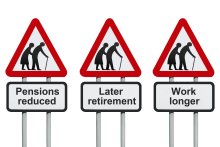PA PENSION ‘REFORM’ TALKING POINTS
We support the defined-benefit pensions provided through Pennsylvania School Employees Retirement System and State Employees Retirement System for current retirees, current school and state employees and future employees. Defined-benefit pension plans are the most cost-effective way to provide retirees with stable, secure retirement income, maintain the standard of living they worked to attain during their careers and keep them from slipping into poverty after retirement.
PSERS and SERS have provided stable and secure retirement income for public employees for 100 years – through recessions and the Great Depression. Longevity risk pooling allows pension funds to recover from even the most severe economic downturns.

Defined-benefit plan investment returns are higher than with individual accounts because defined-benefit plans can pool large sums of money over long periods, accept greater risk and are professionally managed at lower cost than individual retirement accounts.
Teachers, nurses, and other public employees make responsible contributions to their own pensions. Employee contributions range from 6.25 to more than 12.3%. School and state employees have contributed an average of 6.7% of every paycheck to their fund their own retirement benefits.
During two previous administrations (2001-2010) when investment returns were high, the legislature allowed school districts and the state to take an extended "contribution holiday” during which they contributed little or nothing to PSERS and SERS, while employees made their full pension contributions.
During the 10-year employer contribution holiday, employees contributed more money to PSERS and SERS than did their employers during the same period. (Office of the Budget, Keystone Pension Report, Page 2)
The vast majority of pension benefits are paid from investment income (71%), not by taxpayers. Employees contributed $8.2 billion, while employers contributed $4.4 billion from 2001-2011.
More than a dozen states (including California, Minnesota and Texas) have evaluated similar pension reform proposals and concluded that because of higher costs and lower investment returns, moving new employees to defined contribution retirement plans would not be the best course.
Three states (Alaska, West Virginia and Michigan) that closed existing pension plans and moved new employees to 401(k)-type or hybrid plans saw pension debt skyrocket.
In 2013, two state pension consultants projected that Gov. Corbett's pension reform would increase Pennsylvania's pension debt (or unfunded liability) by more than $40 billion as a result of lower investment retires.
In 2010, the Legislature enacted comprehensive, bipartisan pension reform (Act 120) which, if allowed to do what it was designed to do, will restore PSERS and SERS funding levels, gradually, while still providing secure retirement income. Under Act 120, employees made significant sacrifices, including:
• Raising the age at which new employees become eligible for pensions
• Reducing the multiplier used to calculate pensions for future employees
• Eliminated lump-sum withdrawals with interest
• Doubling the vesting period for new employees from 5 years to 10 years
• Capping annual increases of employer contributions
• Creating a system of “shared risk” between employees and employers should investment returns fail to meet projections.
The governor’s proposal to convert new employees to a 401(k)-type plan would cost school districts more for new employees (3% on average, compared to 2.2% of payroll now) and would increase Pennsylvania’s pension debt (unfunded liability). Gov. Corbett’s proposal for new employee pensions would increase costs to $179 million annually by 2050, undoing the cost reductions under Act 120. (Keystone Research Center)
The governor’s proposal to cut current workers’ pensions risks court reversal for violation of constitutionally protected contracts. It leaves the state uncertain of pension costs for many years while spending the illusory “savings” that would have been used to pay down the state’s pension obligation under Act 120.
• Article 1, Section 17 of the PA Constitution prohibits the state from making laws that alter existing contracts.
• Two 1984 court cases upheld the pension plans as contractual agreements (APSCUF v. State System of Higher Education and Pennsylvania Federation of Teachers v. School District of Philadelphia)
Defined-benefit pensions are fiscally responsible for taxpayers as well as retirees. A National Institute for Retirement Security (NIRS) study finds that defined benefit plans deliver the same benefit at roughly half (46%) the cost of defined contribution (401(k)) or hybrid plans. http://bit.ly/VSS1nb
Defined-benefit pensions are a major source of economic stimulus in Pennsylvania that ripples through the economy and benefits all Pennsylvanians. (National Institute for Retirement Security, www.nirsonline.org)
• For every $1 of tax money invested into public employee pensions, $7.95 is generated in consumer spending in Pennsylvania.
• 90% of PA pension benefits are spent in the state, generating economic growth and local jobs. (PSERS Comprehensive Annual Financial Report, 2012)
• In 2009, pension spending supported nearly 100,000 PA jobs paying $4.8 billion in wages and $1.8 billion in tax revenues. (NIRS)
The average pension in PA is hardly lavish at $24,000/year. Nevertheless, defined-benefit pensions keep seniors out of poverty. Retirees without defined-benefit pension plans are 9 times more likely to slip into poverty after retirement and require public assistance in the form of food and cash assistance. (NIRS)
Recommended Resources:
1. Digging a Deeper Pension Hole, Keystone Research Center, Feb. 26, 2013, http://bit.ly/13g9xX7
2. Paying More for Less, Keystone Research Center, Feb. 26, 2013, http://bit.ly/13lpc7k
3. Issue Brief: The Great Recession: Pressures on Public Pensions, Employment Relations and Reforms. National Institute for Retirement Security, November 2012, http://bit.ly/12oI8CU
3.PBS Frontline: The Retirement Gamble. (Video) The PBS special raises troubling questions about how Wall Street protects American's retirement nest egg.
